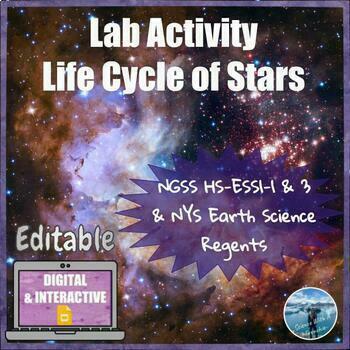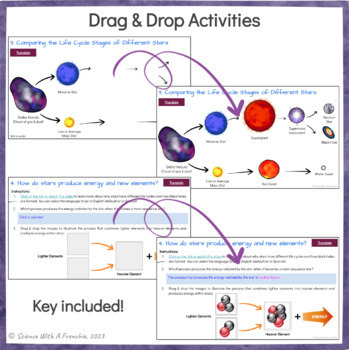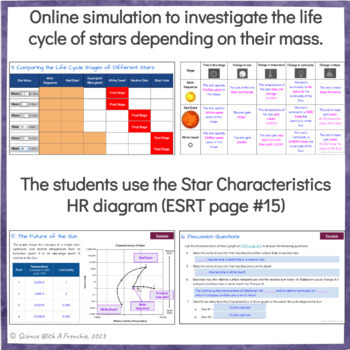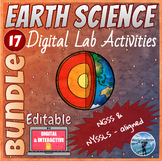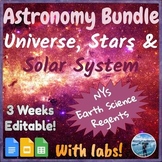Life Cycle of Stars | Digital Lab Activity | Editable | NGSS
- PDF
- Google Apps™

Also included in
- These digital Earth and Space Science lab activities are ideal for topics where hands-on lab activities may be difficult to complete. They are aligned with NGSS and the New York State (NYS) Earth Science curriculum to prepare the students for the Regents exam. All the labs are editable and interactiPrice $43.50Original Price $57.50Save $14.00
- This astronomy bundle covers everything your students need to know about the Universe, Stars, and the Solar System for the New York State (NYS) Regents exam. It includes guided notes with practice questions, teacher presentations, 3 digital and interactive lab activities, and 3 self-checking digitalPrice $33.20Original Price $41.50Save $8.30
Description
In this Google Slides™ digital lab activity, the students will use a simulation to investigate the life cycle of stars based on their initial masses. They will notice a relationship between the mass of a star and how it evolves. This is an interactive lab activity with a link to an online simulation (Star in a Box), a PBS video, and drag & drop features. The students will use the online simulator to create a model that shows the cycle stars go through, from the formation of the star to its death. They will then use their model to make predictions about when and how our star, the Sun, will “die.” The students will also analyze the Hertzsprung-Russell diagram and answer Regents questions.
ESL Strategies: This lab activity is scaffolded for English Language Learners (ELLs):
- Each slide contains a “Translate” hyperlink button to translate the text into any language supported by Google Translate.
- It includes sentence starters to help ELLs structure their answers. The document is editable so you can remove the sentence starters if your students don’t need them.
- The video is in English and Spanish.
Standards: The level of this lab is perfect for 8th grade or high school. This lab activity aligns with:
- NGSS HS-ESS1-1: Develop a model based on evidence to illustrate the life span of the Sun and the role of nuclear fusion in the Sun’s core to release energy that eventually reaches Earth in the form of radiation.
- NGSS HS-ESS1-3: Communicate scientific ideas about the way stars, over their life cycle, produce elements.
- New York State Physical Setting/Earth Science Core Curriculum 1.2b - Stars form when gravity causes clouds of molecules to contract until nuclear fusion of light elements into heavier ones occurs. Fusion releases great amounts of energy over millions of years.
- The stars differ from each other in size, temperature, and age.
- Our Sun is a medium-sized star within a spiral galaxy of stars known as the Milky Way. Our galaxy contains billions of stars, and the universe contains billions of such galaxies.
- NYS Regents skills: The students will use the star characteristics / HR diagram on page #15 of the Earth Science Reference Tables (ESRT).
Editable: You can edit the text of this lab activity by clicking on “View” → “Theme Builder”. However, due to Term of Use agreements with clip art artists, some of the background images aren’t editable.
Digital: This digital lab activity was created with Google Slides™. It can be used in person or for distance learning. Share the Google Slides™ with your students via your Google Classroom. Make sure you select “Make a Copy for Each Student” while you are creating the assignment.
You may also be interested in the following digital activities:
- Pixel Art - HR Diagram & Star Characteristics
- The Doppler Effect - Evidence for the Big Bang Theory - Digital Lab Activity
- Graphing the Planets of the Solar System - Digital Lab Activity
- NYS Earth Science Digital Lab Activities - Growing Bundle
⭐ My store is new, follow me for notifications about new resources coming soon! ⭐

